Chapter XV: Portland to the Promised Land
of Travels with Samantha by Philip Greenspun
AAA puts their magic dots next to I-84 as it follows the Mighty Columbia
from Portland up to the high plains. The river has been substantially
tamed by a series of dams and no longer carves its gorge with such
ferocity. Nonetheless, the dry sculpted hills on both sides of the
river are spectacular, as are the whitecaps on the mile-wide river
stirred up by the relentless 30 mph wind. Despite unwelcoming weather,
the river was teeming with hundreds of expert windsurfers. This is
supposedly one of the best places in the world for the sport, but I
wouldn't try to learn here, what with other guys roaring past at 25 mph
and waves big enough to break an ankle.
"Warning, last Burgerville for 26,000 miles," read a billboard reminding
me that I was leaving the Pacific Northwest. A couple hours out of
Portland and one realizes why so many braved the hardships of the Oregon
Trail back in 1843 ("the cowards never started and the weak died along
the way"). With a little irrigation, this is some of the richest
farmland in the world. Eastern Oregon's plains burst with fields of
wheat and corn surrounded by grassy hills for grazing cattle.
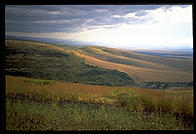 Every hour of driving brought clearer weather, and I was enjoying the
late afternoon light shining on the alternately green and golden hills.
The eastern half of Oregon is so dry, vast, and open that it is
difficult to remember that it is part of the same state as the wet,
densely forested western half.
Every hour of driving brought clearer weather, and I was enjoying the
late afternoon light shining on the alternately green and golden hills.
The eastern half of Oregon is so dry, vast, and open that it is
difficult to remember that it is part of the same state as the wet,
densely forested western half.
After six high-speed hours, I encountered a massive storm system
centered above Baker City. My first view was of a dark patch in the sky
with three wide rainbows coming down. These were the widest, richest,
most saturated rainbows ever. As I drew closer lightning appeared on
the hilltops. Not your average everyday lightning thrown down by Zeus
on unworthy earth-treading mortals. Lightning thrown sideways
across hilltops, stretching horizontally for at least half a mile. Zeus
fighting with other gods. As I entered the storm, heavy clouds shrouded
the lightning, which was now only perceivable as an ominous general
illumination.
MIT freshman physics was 14 years ago, but I remembered that an electric
field can't be established inside a Faraday cage.
"I am surrounded by the car. The car is made of steel. Steel conducts.
Charge will flow through the body instantly to counter the
externally applied field that leads to lightning. Lightning will
therefore go around the car."
Repeating this mantra didn't entirely banish my primal fear. Something
about storms prevents rational thought.
This is easily verified by picking people at random to ask why it is
safe to be in a car during a lightning storm. "Because of insulation
from the rubber tires" is the common answer. "Is air an insulator?"
you may ask. "Yes," they'll respond. "Then a lightning bolt that has
punched through a mile of air is going to be stopped by an inch of
rubber?" "I think so."
Saturday, August 21
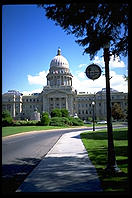
Boise
boasts many attractive stone or brick buildings, including the classical
State Capitol,
and retains some historic charm despite a few 15-story monstrosities.
Lunching at a yuppie French/vegetarian/Tex-Mex cafe, I perused the
Boise Weekly alternative newspaper. The Idaho Shakespeare
Festival was concentrating on the lighter side of romance this summer
(Midsummer Night's Dream), but the destructive lust and state
coercion of Measure for Measure has spilled out right onto the
cover page. It turns out that fornication, cohabitation, and adultery
are still criminal offenses in Idaho. My favorite is the sodomy law:
"Every person who is guilty of the infamous crime against nature,
committed with mankind or with any animal, is punishable by imprisonment
in the state prison not less than five years."
It would be a shame if a modern-day Angelo appeared to enforce these
laws because every other woman in Boise was a tall, beautiful blonde.
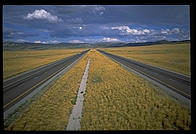
Driving from Boise to
Salt Lake
helped me appreciate how much space we Americans have. Half of the four
lanes were closed, and traffic was squeezed into one lane for each
direction. This was August, the peak travel month, and there is only
one Interstate linking the two biggest cities in the region. Yet
traffic merely slowed from 65 to 55 mph.
Just before the Utah border, I passed a casket manufacturer's truck
emblazoned, "Drive Safely, Heaven Can Wait" and "Giving Dignity to Life
(TM)." The highway surface improved as I left Idaho, but the few traces
of civilization disappeared. There wasn't a McDonald's for 200 miles,
just ranches and farms and "No Services" signs tacked to the infrequent
exits.
Here in Zion, one of the evils of life that has been banished is getting
lost. Virtually all towns in Utah, from the smallest right up to Salt
Lake, are organized on a Cartesian coordinate system. If you need a map
to find an address, then part of your brain is on hold. If you can't
find Temple Square, which is smack in the center of the grid and
well-signed, then you have no brain at all.
Temple Square, "Dedicated to the Sacred Principle of Religious Freedom,"
is a compact confection of gleaming white buildings, freshly scrubbed
twentysomething women giving tours in 15 languages, and mostly
well-dressed respectful tourists. Slumping in lumpy contrast to this
prosperity are, well, bums. Down-and-outers of various descriptions
line the public sidewalks near the entrances to the square holding
signs: "Stranded; need money to get bus back to L.A." or "Drug-free
mother with three kids needs help."
Temple Square has two visitors' centers explaining the faith of the
Church of Jesus Christ of Latter-Day Saints. Series of paintings
illustrate the Old Testament, the New Testament, and the Book of Mormon.
I stopped first at the genealogy database public access terminals. The
Mormons have the world's largest collection of birth and death records.
They do this because they have an answer to an Enlightenment criticism
of Christianity: If Faith in Jesus is the only way to get to Heaven,
then a lot of virtuous Indians and Chinese are out of luck. Would a
benevolent God have really set up the world so that people who were
unlucky to be born in a place without Jewish/Christian bibles would all
go to Hell?
Mormons answer this with a resounding "No!" They are going to convert
all the dead souls they can find to the LDS church. Individual Mormons
like to convert their own ancestors but also take upon themselves the
selfless task of converting (dead) strangers. Souls are eternal, by the
way, and the dead soul retains its freedom to reject Mormonism and
salvation.
Dead Greenspuns will apparently all rot in Hell for awhile; there
weren't any in the database.
Legacy draws full houses every hour in the plush Joseph Smith
center, a refurbished 1911 grand hotel. A big screen and 70 mm
projectors grace the 500-seat theater. Legacy is as engrossing
as any Hollywood picture and beautifully photographed. The story starts
with a young woman's 1830 conversion in New York. She watches her
brother die with 16 other Mormons in the 1838 Haun's Mill (Missouri)
massacre. State governors were shown ordering troops to tar and feather
or expel Mormons.
This isn't as bad an infringement of constitutional guarantees as it
appears. The Bill of Rights originally restricted actions only by the
federal government. In 1833, the Supreme Court specifically wrote that
the Bill of Rights did not restrict actions by state governments (Barron
v. Baltimore). It wasn't until the Fourteenth Amendment's ratification
in 1868 that the U.S. Constitution guaranteed civil liberties for
individuals against the states.
A period of comparative peace follows, with proselytizing in England and
painstaking temple building in the thriving settlement of Nauvoo,
Illinois (pop. 15,000). The murder of Prophet Joseph Smith by a mob in
1843 darkens the mood again. The final exodus to Utah, lead by Brigham
Young, doesn't look like much fun: hard miles through Iowa, up the
Platte River through Nebraska into Laramie, Wyoming, then across the
Green River and down into Salt Lake City.
David, a retired Salt Laker, and his son Doug, an engineer from
California, sat next to me. They were quite anxious for me to join
the 8.5 million Mormons, as was Doug's wife Sue, a convert 23 years
ago (and now mother of six).
"We like Jews, especially Israeli Jews, and pray for the Jews to
return to Israel because that brings Jesus closer."
"You can pray all you like, but until Israel gets proper heating and
air conditioning, they'll pry my American passport out of my cold,
dead hand," I responded. "Hey, and speaking of Israel, I know the
Lord moves in mysterious ways, but my visit there really jarred my
common sense: this is the promised land?!?"
Mark Twain had the same sentiments back in 1869: "Monotonous and
uninviting as much of the Holy Land will appear to persons accustomed
to the almost constant verdure of flowers, ample streams, and varied
surface of our own country, we must remember that its aspect to the
Israelites after the weary march of 40 years through the desert
must have been very different."
"Israel was just a way station," Doug explained. "Around 200 B.C., God
moved a couple of tribes of Jews out of the Persian Gulf in boats, and
they sailed for the real Promised Land: America. Descendants of these
tribes became the American Indians."
So Mormons reject the theory that American Indians came over from Siberia?
"Absolutely."
How could the Jews, a people for whom literacy is the sine qua
non of adulthood, evolve into illiterate Indians?
"That's all explained in the scripture. Basically it came down to
internecine conflict."
It is not too hard to argue that North America is the best piece of real
estate on the planet, but isn't Utah a little inhospitable to be
Zion?
"`Zion' means different things in different contexts. Salt Lake isn't
Zion. Joseph Smith identified the Garden of Eden in Missouri, and that
is where the church is going to build Zion and the New Jerusalem
eventually, as soon as enough land has been bought up."
Is it going to be like John Calvin's theocratic Geneva, where civil
authority was used to coerce people into obeying religious law (a woman
was fined for "making a rude noise in church")?
"Absolutely not. We think the U.S. Constitution was divinely inspired.
Mormons don't want any more power than that of excommunication."
How can they have such faith in a document and system that had failed
them in their time of need?
"It is true that the Mormons petitioned President Van Buren to do
something about Missouri's illegal extermination order, but he made a
political decision not to," Doug noted. "However, we have faith in the
American system."
Sunday, August 22
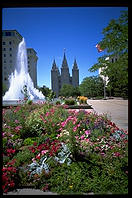
After hearing the Mormon Youth Symphony and Chorus perform in the
Tabernacle, I walked out into the blinding light of Temple Square.
Keith dropped out of high school in Illinois and moved here nine years ago.
"I was on my way to Vegas and never made it."
Dressed in denim work clothes, he holds a cardboard sign reading, "Out of
Work and Homeless; Please Help."
Won't the Mormons help him?
"They are better at helping their own. Oh, I could go to their work
center and stay for three days, but they don't pay you, just give you
credits against food and clothing. A friend of mine came here from
Boston. He'd been baptized in the church but never practiced. He went
to see a bishop, was looked up in the computer, and the bishop put him
up in a hotel room for two weeks. He got a job within two days. They
take care of their own.
"I'm living in an abandoned apartment right now. It's pretty good;
nobody bothers me. But I shouldn't have quit my last job. My
girlfriend wants to get a place together. I didn't like working in that
restaurant, but I only made $9 yesterday from tourists. And every time
I light a cigarette, a Mormon will come over and say, `I wish I had
enough money to smoke.' They say it is a sin, but they do it. A friend
of mine is an archaeologist and he says, `You should see the stacks of
whiskey bottles I've found at old Mormon sites.'"
Does he personally know any polygamists?
"I've seen quite a few walking around Salt Lake. The most flagrant
was a guy from southern Utah. He had 16 wives, but they couldn't touch
him. Legally, he'd only married the first. She signed something
giving her consent to the other 15 living with them."
Trying to learn about polygamy in Temple Square is a bit like trying
to learn about the Nazis in Germany; it is the part of local history
that outsiders find most interesting, but nobody wants to talk about
it. Young Mormons around the temple go by "Brother Joe" or "Sister
Judy" or whatever, but there is a class of folks who go by "Elder
Smith" or "Elder Jones." Elder Pomeroy, a graying information
resource, gave me a good education on the subject of polygamy.
"Joseph Smith had a divine inspiration in the early 1840s that led to
the institution of polygamy. There wasn't a shortage of men or
anything, and in fact Prophet Joseph was very unenthusiastic and
unhappy about the idea."
Mark Twain looked at the Mormon women in 1872: "I warmed toward these
poor, ungainly, and pathetically homely creatures.... `No--the man
that marries one of them has done an act of Christian charity which
entitles him to the kindly applause of mankind, not their harsh
censure--and the man that marries sixty of them has done a deed of
open-handed generosity so sublime that the nations should stand
uncovered in his presence, and worship in silence.'"
Smith and Twain's sentiments notwithstanding, the U.S. government was
downright hostile to polygamy from Day One.
"My great-grandfather was a polygamist and he was fined and chased by
U.S. marshals in Arizona Territory. The Church fought for religious
freedom all the way up to the Supreme Court in the late 1880s, but
ultimately lost. Congress passed a law that would confiscate all
church buildings, funds, and assets if polygamy continued. Although
this practice had been ordained by God, Mormon theologists tried to
reconcile it with passages in the scripture requiring obedience to
civil authority. Polygamy was abandoned in 1890 and that paved the
way for Utah's statehood."
I subsequently asked a "man-in-the-street" Mormon if he knew any
polygamists.
"Only two. One lives in Colorado City, Arizona, where there is a
community of about 2000 polygamists.
Economically, they manage to live fairly diversified lives, winning
construction contracts all over the West. My friend there has three
wives in one big house. The other is my aunt. Her husband read the
scriptures carefully and took a 19-year-old girl as another wife. My
Aunt, who was 40 at the time, was very angry, and my father (her
brother) wanted to kill the polygamist. But my uncle eventually
convinced everyone that this was the right way to live and they've
worked it out."
Do they sleep in the same bed?
"No, it isn't the kind of wild sex party that people imagine. In fact,
the old polygamists used to maintain each wife and set of children in
her own house. They wrote in their diaries about how difficult it was.
They really didn't want to do it."
Oddly enough, the last time I was in Phoenix, local TV news was abuzz
over some litigation in Colorado City. A dispute there over property
spilled out into the federal courts and all the lurid details of life
there became public. One litigant complained that another had stolen
two of his wives and added them to his harem of seven.
My last stop in Temple Square was the new Mormon Museum, which recounts
the history of the migration of the Mormons and the rigors of the Mormon
Trail. An exhibit upstairs documents the design and decoration of the
Temple, finished in the 1890s and off-limits to non-Mormons. The
structure is a bit heavy and graceless, but one can't fault the church
for skimping. They sent a group of their best artists to Paris for a
proper education. When they came back to Salt Lake they did some nice
Impressionistic paintings for the interior. A golden statue of the
Mormon angel, somewhat unfortunately named "Moroni," adorns the top.
I walked out of the museum mostly astonished by how they underplayed the
vicious persecution of Mormons by their fellow Americans. I was upset
that I'd learned so little of the failure of the Constitutional
guarantees in grade school. The unfairness of the taking of Indian
lands was covered in great detail, but the Mormon experience, which
offers a much more disturbing caution to our present age, was hardly
mentioned. Nobody seriously expects a repeat of the European/Indian
conflict if only because we already took all the Indian land that we
wanted. However, conflict between religious cults and the state is
ongoing. Just ask David Koresh, the Rajneeshi, or even the Christian
Scientists. Given the erosion of civil liberties over the last decade
in the name of the Drug War, all Americans might do well to ponder the
Mormon experience.

Gorgeous two-lane roads through coal and uranium mining country took me to
Moab, Utah.
I listened to Ishiguro's The Remains of the Day. When I read this
a few years ago, it didn't resonate with me. On second encounter,
Ishiguro's English butler reminded me of many of my friends.
He's sacrificed everything in order to do his job well and at a late age
begins to question whether it was worth it.
Monday, August 23
There are two ways to become Christian in Utah. One is to fall in love
with a Mormon missionary. The other is to ride the Slickrock
Trail.
"O man, citizenship of this great world-city has been yours. Whether
for five years or fivescore, what is that to you? Whatever the law of
that city decrees is fair to one and all alike. Wherein, then, is your
grievance? You are not ejected from the city by any unjust judge or
tyrant, but by the selfsame Nature which brought you into it; just as
when an actor is dismissed by the manager who engaged him. `But I have
played no more than three of the five acts.' Just so; in your drama of
life, three acts are all the play. Its point of completeness is
determined by him who formerly sanctioned your creation, and today
sanctions your dissolution. Neither of those decisions lay within
yourself. Pass on your way, then, with a smiling face, under the smile
of him who bids you go."
--- Marcus Aurelius before Slickrock (12:36)
"Dear God, thank you for making me emperor. I shall forever hallow Thy
name for keeping my gonads off the top tube. Would it test Thy
greatness to keep me from sneezing so I don't get a face-first tour of
Negro Bill Canyon?"
--- Marcus Aurelius on the Slickrock
This used to be known as "Nigger Bill Canyon", after a 19th-century sheep
farmer who lived in the area. A proposed name change to
"African-American William Canyon" was defeated in favor of the current
compromise.
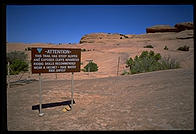
Even setting aside the politically incorrect canyon, the names of
Slickrock features are not comforting. "Hell's Revenge" and "Abyss"
jump out of the map. The trail was created in 1969 by a motorcyclist.
He painted white stripes on the rounded sandstone features for 14
miles and about 200 dirt bikers each year were crazy enough to attempt
it. Several years ago the trail was discovered by America's mountain
bikers, and they've inundated the town to test their mettle.
There is a 2.5-mile "practice loop" alternative to the main trail. It
isn't any easier than the main ride, just shorter. This is no small
consideration when one considers the 100-110 degree heat and
unavailability of water on what is normally a very strenuous four-hour
ride. Slickrock winds through a landscape of fantastic beauty: red
sandstone sculpted into towers, canyons, squatting lumps, and the
Colorado River flowing through it all. Scrubby trees soften one's
immediate environment, and the 12,000' La Sal Mountains covered with
trees and/or snow provide a pleasant backdrop.
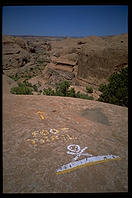 Here is a typical sequence of the Slickrock. Step One: Survey the
landscape from the top of a 40'-high lump. Step Two: Bike straight
down the 30-degree side into a pit about the width of your bike tire.
You've two choices here: don't brake or brake. If you don't brake,
you'll crash into the pit at 35 mph. If you brake, little bumps on
the way down will hurl you over the handlebars at 15 mph. Whatever
you choose, remember to get off the brakes and adjust your weight so
that your bike doesn't get stuck in the pit and send you flying over
the handlebars and into the next rock. Step Three: Start up the next
40' lump. The 30-degree slope will have you standing on your pedals
in the lowest of your 21 gears. Remember to keep your weight forward
or you will lift the front wheel and fall off the back of the bike.
Step Four: Get to the top exhausted from the heat, climb, and thinnish
air at 4500'. Step Five: Drink from your dwindling water supply; go
to Step One.
Here is a typical sequence of the Slickrock. Step One: Survey the
landscape from the top of a 40'-high lump. Step Two: Bike straight
down the 30-degree side into a pit about the width of your bike tire.
You've two choices here: don't brake or brake. If you don't brake,
you'll crash into the pit at 35 mph. If you brake, little bumps on
the way down will hurl you over the handlebars at 15 mph. Whatever
you choose, remember to get off the brakes and adjust your weight so
that your bike doesn't get stuck in the pit and send you flying over
the handlebars and into the next rock. Step Three: Start up the next
40' lump. The 30-degree slope will have you standing on your pedals
in the lowest of your 21 gears. Remember to keep your weight forward
or you will lift the front wheel and fall off the back of the bike.
Step Four: Get to the top exhausted from the heat, climb, and thinnish
air at 4500'. Step Five: Drink from your dwindling water supply; go
to Step One.
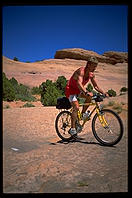 Here is a less typical, but even more invigorating section. Ride
along a horizontal contour of a 25-degree slope, amazed all the time
that your bike tire grips the sandstone. Stare in disbelief as the
trail makes a tight 180-degree turn. Contemplate getting off the bike
but realize that stopping will start you tumbling sideways down a 100'
slope to a dry canyon bed. Make the turn realizing that a 5-degree
error in steering will plunge you straight down the same slope.
Repeat three times then go to preceding sequence.
Here is a less typical, but even more invigorating section. Ride
along a horizontal contour of a 25-degree slope, amazed all the time
that your bike tire grips the sandstone. Stare in disbelief as the
trail makes a tight 180-degree turn. Contemplate getting off the bike
but realize that stopping will start you tumbling sideways down a 100'
slope to a dry canyon bed. Make the turn realizing that a 5-degree
error in steering will plunge you straight down the same slope.
Repeat three times then go to preceding sequence.
A combination of aerobic fatigue, 97-degree weather, and stark terror
left my energy reserves and water bottles dry at the end of the
2.5-mile loop. After a refreshing dip in Ken's Lake, a lovely
reservoir, I drove back to downtown and hung out at Mondo Espresso in
front of Kaibab Bike. Terry and Rebecca dipped into a $3000 Italian
machine and served me a fine ice and fruit slush supplemented with an
education on the local mind-set.
"We called contractors just after we moved here, and they came over and
gave us estimates. After three weeks we wondered why they hadn't showed
up. Friends clued us into `Moab Fever,' which might otherwise be
described as laziness. People come here and throw away their calendars
and watches. Every business is open 7 days a week, the supermarket is
24 hours a day. Knowing the day or date is almost worthless
information. One time I had to dig out a supermarket receipt to figure
out what day it was."
The bike rack in front of Kaibab is a lot like the valet parking lot of
the Beverly Hills Hotel: Lycra-clad drivers drop off the world's most
expensive custom-made machines plus a bunch of absurdly expensive
mass-produced ones. At Kaibab, however, all the machines are American
and most are badly dented and scratched. Clark, the shop's assistant
manager and some visitors were chatting about how lonely life here can
be for a single guy in this town of 6000. Apparently it is not the
place to meet that Lycra-clad beauty in the Raleigh ad.
"I've ridden here every day for four years and can count on the fingers
of one hand the number of single women I've seen on the trail."
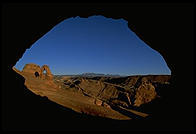
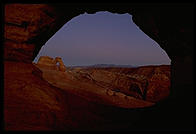
In nearby Arches National Park, I hiked 1.5 miles to the
perfectly formed Delicate Arch. Germany's goodwill ambassadors were
out in force. Christina is in her last year of gymnasium and came
here with 20 other Germans in a tour bus. She's hardly spoken any
English since she came here and not gotten to know any Americans.
"People look at me funny when I smoke in shops here. We all smoke in
Germany, what is wrong with people here?"
I explained to her a bit
about American smoking etiquette. Would she smoke around a fellow
German with a respiratory problem?
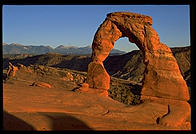 "People like that should stay home."
"People like that should stay home."
I wasn't surprised to learn that Christina's tour was organized by
Marlboro cigarettes. I wondered what our Joe Camel protesters would
think about a cigarette company sponsoring youth travel.
A large group of folks sat on a rock overlooking the arch while a
smaller number walked around having their pictures taken right up
against it. One family sat themselves down smack underneath the arch.
They were looking out over a canyon with their backs to us. A
thirtysomething German kneeled 40 yards away with his camera.
"Do we all have to take your picture? There are other places to sit,
you know," he hollered at them in heavily accented English.
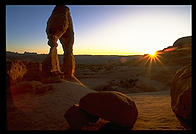
It dawned on me that this might well be the best way to motivate a
German, i.e., to convince him that he could be a better citizen. Most
Americans, however, instinctively know that the best way to motivate a
fellow American is to convince him that he could do you a favor,
e.g., "I would really appreciate it if you would ..."
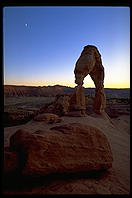
Delicate Arch at sunset inspired the burning of a whole roll of
film. I clambered up to a car-sized arch-shaped hole in one wall and
mounted an ultrawide 20 mm lens on the Nikon. The rim of the hole was in
shadow, making a black frame for the picture. Delicate Arch sits in the
middle of the frame, with the La Sal Mountains behind, all glowing
warmly in the setting sun.
Moving closer to the 46'-high arch, I used a tripod and small aperture
to turn the setting sun into a starburst over the red rocks of the
foreground. Almost everyone else left, but I stayed to capture the moon
over the arch and the La Sal Mountains with 15- and 30-second exposures.
I finished up where I'd started, capturing the same scene of hole-framed
arch in the fading twilight before hiking down the dark trail.
Tuesday, August 24
Utah's Route 128 is devoid of its Massachusetts namesake's biotech and
computer firms, but its path at the bottom of the Colorado River's
canyon more than makes up for it. Dams at numerous points on the river
keep river levels constant so that a good highway can snuggle right up
to the riverside, making for an almost entirely flat bike ride.
Enormous sandstone cliffs tower above the road while lush vegetation
flanks the silty river. It would have been a perfect ride had the
temperature not been about 100.
Cruising smoothly through a beautiful canyon at 13 mph with a cool
breeze in my face, I had to admit that pavement has its advantages. The
silence was broken only every five minutes or so by the passage of a car
on its way to Colorado.
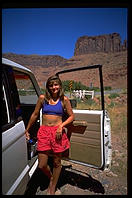
Her Isuzu Trooper loaded with bike and camping gear, Lisa sat on a
streamside rock reading Zen and the Art of Motorcycle
Maintenance. Only about 15% of her elfin tawny body was covered
with shorts and halter top.
Lisa has been out of college for three years and wants to do something
with her degree but can't get the travel bug out of her system.
"I can save $5000 in one winter waitressing in Vail. Then I'm off.
My first trip was a $600 five-month tour of France, England, and
Ireland. I hitchhiked with ex-cons, stowed away on ferries, and ate
spaghetti and porridge until it made me sick to look at either
again."
Was she alone?
"Just as I was leaving the U.S., my friend Brett said, `I've always
wanted to do that.' He quit his law firm and came with me. We were
barely speaking to each other after a few months. He was always
flaunting his Yale degree but never really impressed me or anyone else
with his learning or intelligence.
"`Why did you take this trip, Brett?' I asked him.
"`I wanted to have some stories to tell,' he responded.
"`So you are working on your travel resume.'"
I figured this would be the ideal time to tell my one lawyer/biker joke:
"If you are driving along and see a lawyer on a bicycle, why don't you
swerve to hit him? ... Because it might be your bicycle."
Brett fell in love with Lisa, but only managed to join her substantial
stack of broken hearts.
"Men fall in love with me because of my independent spirit and then want
to hold me; I don't understand it."
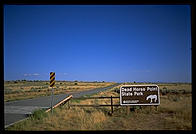
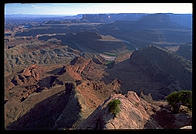
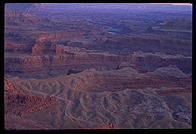

After a photo safari to Dead Horse Point, overlooking Canyonlands
National Park, I stopped back at the Lazy Lizard, where Michael, a
German university student, asked me how I'd liked Berlin. I told him
how interesting I thought it was, especially the tension between
Russian and German monuments, the Nazi history, and the Turkish
neighborhoods.
"Don't you think attitudes in Germany have completely changed?" he asked.
"Frankly, no," I answered. "I'd say the attitude toward Turks today is
more or less the same as it was toward Jews in the Old Days: `Here are
a bunch of outsiders living off of us Germans who've worked hard for
centuries to build this society.' Furthermore, I'd heard quite a few
well-educated good-hearted Germans say many of the same things about
Jews that the Nazis did."
This set off a firestorm of criticism from all sides.
An English guy said that what the Nazis did to the "inferior races of
Europe" was no worse than what the U.S. did to the Indians. In fact, he
went on, "I've been here for four months and Americans today are just as
racist as Germans ever were."
Had he heard any American advocate any kind of action against someone
because of his race?
"No, but I saw a bumper sticker on a car here that said, `Zap Iraq.'
... Anything the Germans might have done is ancient history. Young
people today are completely different and much more educated about the
world. The main threat to the world today is the U.S."
Colin, a New Zealander, said it was unfair to criticize the Germans
because the Israelis were as bad as the Nazis ever were.
"I got through the border in a few minutes, but they spent an hour
questioning an Arab going through. Palestinians can't vote or work."
Colin was unaware of the distinction between Arabs in the Occupied
Territories and those in Israel proper. I asked him if New Zealand
would be happy to give the vote and full political rights to a group of
people who had evinced no desire to be part of New Zealand and in fact
had fought several unsuccessful wars to take over the country. Colin
changed the topic.
"Well, I think it is really obnoxious that Jews consider themselves the
chosen people and that Israel gives special treatment to Jews. Isn't it
time to move beyond religious labels?"
Colin had traveled all over the world and had found only one constant:
Israelis are obnoxious and unwelcome everywhere.
"There are lots of hotels and restaurants where they won't even let
Israelis in because they are so rude. Why aren't they better
ambassadors for their country?"
The only one willing to distinguish the Nazis from other world
malefactors was Michael, the German student.
"No one else was as organized as the Germans."
He understood why Jews were a natural target for the Nazis, though.
"They controlled all the banks and media and were dominant in medicine
and law. There were 2-3 million Jews in Germany then."
I tried to defuse the argument by reminding folks that I hadn't passed
judgment on anyone but only said that I didn't think German attitudes
had changed much.
"The main lesson I would expect Germans to draw from World War II is
that attacking the U.S. and Russia simultaneously is a bad idea. Why
would attitudes about racism have changed? Attitudes that are
deep-seated in a culture aren't going to change easily. One doesn't
learn about people by killing them; one learns by living with them.
Americans who have day-to-day contact with different cultures tend to
re-evaluate their stereotypes. Unfortunately, since there are
essentially no Jews left in Germany, that option isn't available to
Germans."
Michael violently disagreed with this.
"There aren't any young people who are anti-Semitic in Germany anymore.
Germany today is full of Jews. In my life, I've actually met five."
A famous Nazi saying was "500,000 unemployed; 500,000 Jews. Solution is
very simple." Although this slogan might be faulted for its inclusion
of women, children, and elderly, the 500,000 number is well-grounded in
a German census of 1920. By 1937, only about 365,000 Jews remained in
Germany, less than 1% of the German population. These constituted less
than 5% of Europe's Jews. Germany's Jewish population rose by 180,000
when it merged with Austria, but fell dramatically during the Holocaust.
At the end of the war, 5,000 German Jews had survived clandestinely and
12,000 as spouses of Aryans. Between 1948 and 1964, 9000 of these
17,000 survivors emigrated to Israel (sources: Atlas of Jewish
History and The Jews in Germany).
Wednesday, August 25
Humidity, clouds, and rain greeted me in the morning, reminding me how
tame our desert really is. In the Sinai, it rains once every three
years or so, and there isn't a shred of vegetation anywhere. Everything
here is covered in grass, brush, or trees because it actually rains
fairly regularly.
It was a beautiful drive south along the edge of Canyonlands National
Park. Violent crosswinds and occasionally heavy rain made for dramatic
driving; this is not the place to bring the Volkswagen. In a
convenience store in
Monticello,
I met Larry and his wife, a Navajo who'd been placed with a Mormon
family near Salt Lake.
"Our mothers wanted the best possible educations for us. The local Bureau of Indian Affairs school wasn't any good so it was a choice of boarding school or taking advantage of the Mormon program to place Indian children with families."
Were their parents horrified that they'd converted to the LDS church?
"No. They saw it as part of adapting to modern culture."
In their designer clothes and jewelry, I had to admit that they appeared to be some of the better-adapted Navajo I'd met. What had drawn them to Monticello?
"I haven't gotten a job here yet, but my wife has a good job with the
local uranium tailings cleanup operation."
John, an insurance agent, added that "they just finished spending $200
million cleaning up mill tailings here. It was really fine sand, and it
blew out over a bunch of fields. A lot of people actually used it as
building material so now their houses are slightly radioactive.
Brilliant, eh?"
Uranium cleanup is a big industry in Utah right now. A classical form
of contamination was caused by the "big heap" system. High-grade ore
was dug out of the ground and processed. Low-grade rock was just piled
up and left out in the open for 30 years. It wasn't radioactive enough
to be used in bombs or reactors, but it was still hotter than normal.
Three decades of wind blew radioactive dust from these piles all over
portions of Utah. Now government contractors roam around thousands of
square miles in special sniffer tractors finding radioactive topsoil so
that it can be scraped up and buried somewhere.
John was the last Mormon I talked to in Utah and the first who had any
sympathy for David Koresh. In light of their own persecution by the
government, weren't they firm believers in the words of Frederick
Douglas: "No man can put a chain about the ankle of his fellow man
without at last finding the other end fastened about his own neck."?
"Koresh was molesting children" was a typical reaction.
How did they know that?
"We read it in the newspapers."
How would an 1840 newspaper have described their own religion?
"Hmmm."
John thought the government should have left Koresh alone and said that
quite a few Mormons in southern Utah shared his thinking. "Folks here
support the Indians' right to use peyote as a matter of religious
freedom. A lot of people were also cheered by the jury verdict in Idaho
acquitting Randy Weaver."
John told me about Monticello's history.
"This is one of the few cities in Utah that was not settled by Mormons.
We have a Catholic church here and a large Hispanic community, which was
here decades before the Mormons."
As we parted, I got a good illustration of the cultural difference
between Boston and Monticello: I set the yuppie alarm on my $18,000 van
before running into the convenience store; John left the motor running
on his $30,000 Acura Legend.
Randy Weaver footnote, copied from a friend's gun magazine
In October, 1989, a federal undercover agent asked small-time Idaho
gun dealer Randy Weaver for two sawed-off shotguns. Weaver provided
him with guns whose barrels were within 1/4" of the legal limit of
18". Eight months later, Bureau of Alcohol Tobacco and Firearms
(BATF) agents approached Weaver with an offer: become a government
informer or go to jail for selling the shotguns. Weaver refused to
become an informer and was indicted on the shotgun charge.
In January, 1991, Weaver and his wife Vicki stopped to offer
assistance to a couple with a camper stranded by the roadside.
Federal agents came out of the camper. One held a pistol to Weaver's
neck while another threw Vicki to the slushy ground. Weaver was
arraigned before a federal magistrate and went back to his cabin in
the woods vowing never to cooperate with the government or courts.
Weaver was subsequently indicted for failure to appear.
Camouflaged, submachine-gun-toting U.S. marshals surrounded Weaver's
cabin in August, 1992. Kevin Harris, a neighbor, Sammy, Weaver's
14-year-old son, and Striker, a Golden Retriever, went out hunting.
Without warning, an agent fired a burst of shells into the dog. Sammy
fired back with his bolt-action hunting rifle. Government agents shot
the boy in the arm, then in the back as he was running for home.
Kevin Harris killed a U.S. Marshal with a shot to the chest and made
it back to Weaver's cabin.
After the death of the marshal, the cabin was ringed by a huge force
of FBI, BATF, U.S. marshals, Idaho state police, and Idaho National
Guard. The media was out in force also, and Weaver's plywood shack
became a "mountain fortress" and then a "bunker." As Weaver moved
outside the cabin toward his son's body, he was shot in the arm by an
FBI sniper. Vicki was waiting at the cabin's door holding her infant
daughter. The same sniper fired a bullet through her skull. Although
these two had been the only shots fired, the media reported that Vicki
had been "killed in an exchange of fire" or in a "gun battle."
Weaver and Harris surrendered to face murder and other felony charges.
After a 36-day trial, Harris was found not guilty of murder by reason
of self-defense. Weaver was acquitted of the original gun charge.
The government admitted that it had never considered simply knocking
on the door and arresting Weaver.
Note about the source: the gun magazine article from which the above
is taken probably overlooks a few unsavory facts about Weaver but the
Wall Street Journal has run very similar accounts.
|
 Chapter XVI: Colorado
Chapter XVI: Colorado
 Table of Contents
Table of Contents
philg@mit.edu
Related Links
- CyberCycle- This is a site that covers every aspect of biking from purchasing your first bike to repairs and even moutain biking trails. We also have a forum, polls and lots and lots of information on the sport of cycling. This was designed for the ThinkQuest Web Site contest so help us win first place by visiting our site today! Happy riding! :) (contributed by Jen --)
Add a comment | Add a link
 Every hour of driving brought clearer weather, and I was enjoying the
late afternoon light shining on the alternately green and golden hills.
The eastern half of Oregon is so dry, vast, and open that it is
difficult to remember that it is part of the same state as the wet,
densely forested western half.
Every hour of driving brought clearer weather, and I was enjoying the
late afternoon light shining on the alternately green and golden hills.
The eastern half of Oregon is so dry, vast, and open that it is
difficult to remember that it is part of the same state as the wet,
densely forested western half.















